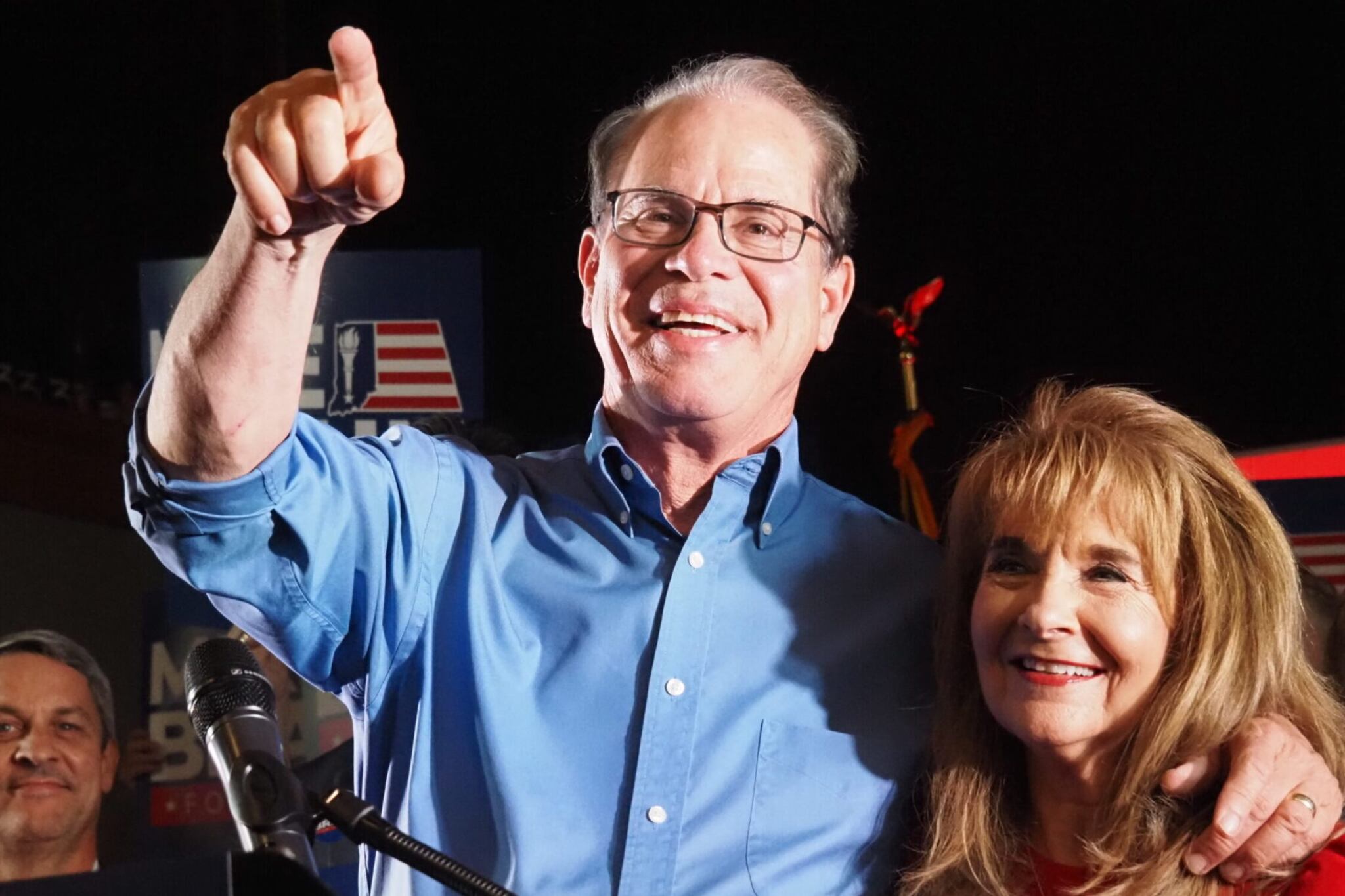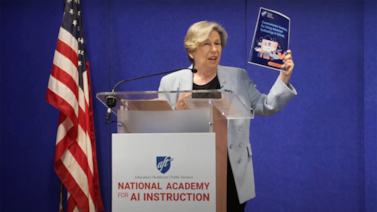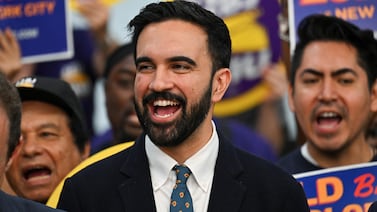Sign up for Chalkbeat Indiana’s free daily newsletter to keep up with Indianapolis Public Schools, Marion County’s township districts, and statewide education news.
This article was originally published by Indiana Capital Chronicle. It was edited by Chalkbeat Indiana and combined with reporting from a voter guide.
U.S. Sen. Mike Braun soundly defeated challenges from five other hopefuls to clinch the Republican nomination in the race for governor on Tuesday, winning just after polls in the Central time zone closed at 6 p.m.
“I intend to be the most entrepreneurial governor the state has ever had; the most accessible,” Braun told the crowds to chants of “I like Mike.”
“We’re going to take this state to a place we’ve never seen before.”
The other candidates running in the Republican primary for governor were: former Secretary of Commerce Brad Chambers, Lt. Gov. Suzanne Crouch, Fort Wayne businessman Eric Doden, former Attorney General Curtis Hill and faith-motivated candidate Jamie Reitenour.
In predominantly Republican Indiana, Braun is likely to be Gov. Eric Holcomb’s successor in November but faces a challenge from Democrat Jennifer McCormick and Libertarian Donald Rainwater. McCormick was the only Democrat to qualify for a gubernatorial run, and Rainwater got the Libertarian nod in a private party convention.
McCormick, in a release, called the choice between Braun and her one of “polarization and division” versus “optimism and opportunity.”
“The primary results are in, setting up a clear choice this November,” said McCormick. “As your governor, I will stand firm in my commitment to the values that define us as Hoosiers. I will fight to restore our reproductive rights and freedoms, champion for our kids, and ensure Hoosiers earn the wages they deserve. Indiana values reflect those of common sense, civility, and bipartisanship.”
Braun said three competitors had called him offering their congratulations during the 8 p.m. speech but didn’t provide specifics. Crouch said she left a voicemail.
Braun consistently led in several polls leading up to Tuesday’s primary, though large blocs of voters appeared to be undecided in the final days of the race.
A group seeking to moderate the extremes of Hoosier politics, Recenter Indiana, endorsed Chambers over Braun and paid for billboards ahead of the May election, urging Democrats to pull Republican ballots.
However, only Braun nabbed an endorsement from former President Donald Trump.
In Indiana, the candidate for the lieutenant governor position is filled in a private convention, but Braun said he would submit a recommendation for his future running mate.
Braun’s stances on education in Indiana
Braun previously participated in a Q&A with Indiana Capital Chronicle about education issues that was published in March. Here’s a look back at what Braun said:
Q: Lawmakers are considering moving to education savings accounts for all Indiana students. Do you support this move and, if so, where do we come up with the new dollars to cover this major school choice expansion?
A: School choice is about Hoosier parents having the freedom to make decisions about their kids’ education. Education savings accounts — where a student’s public funds are kept in an account similar to a Health Savings Account with parents in the driver’s seat — will be something I will look at closely. ESA programs have had success in states like Florida that have tried them, and I’m always looking for ways to put more power in parents’ hands when it comes to their children’s education.
Note: In 2023, the General Assembly included in the state budget a voucher buildout that makes Indiana’s current Choice Scholarship program virtually universal. Currently, ESAs in Indiana are limited to students who require special education services, though a law passed earlier this month expands eligibility to the siblings of students who have an ESA, even if those siblings do not have disabilities themselves.
Q: Indiana’s average teacher salary is currently about $58,531. Gov. Eric Holcomb’s goal has been to increase that average to $60,000. What, if anything, should the state do to raise teacher pay and increase recruitment and retention of Hoosier educators?
A: We spend over half of our budget on K-12 education. Are we getting the best results we can from that investment? We need to make sure Hoosiers’ investment in education is being spent wisely on things that will give students’ better outcomes — like attracting and retaining great teachers — and not being gobbled up by administration, waste, or programs that aren’t showing results. I’ll approach our K-12 education the same way I approached solving problems in my business: rolling up my sleeves and making sure every dollar is getting maximum return for Hoosiers.
Note: Currently, Indiana law requires a minimum salary of $40,000 for each full-time teacher. Most, but not all, Hoosier districts currently meet the salary requirement, however. State data released earlier this year showed that — while the Indiana teacher workforce is growing — fewer teachers are being retained. In recent years, multiple initiatives spearheaded by Indiana lawmakers and state education officials intend to boost teacher numbers. That includes scholarships and multiple other incentive programs meant to recruit and retain students in education preparation programs.
Q: The COVID-19 pandemic contributed to significant levels of learning loss for students across Indiana. Recovery efforts are still underway. What more do you want the state to do to get Hoosier kids back on track? What role(s) should parents play in the comeback?
A: It wasn’t the virus that caused learning loss for our kids. It was keeping schools shut down and our kids in masks long after it was clear that it didn’t make sense. My approach to education comes as a parent and from serving on my local school board for 10 years. Parents are the primary stakeholder in their kids’ education. I clashed with the Biden administration’s secretary of education at a Senate hearing when he wouldn’t accept that simple fact, and it will be the centerpiece of my approach to education as governor.
Q: Indiana is in the midst of increasing credentialing and educational attainment among Hoosiers. Much of the prior emphasis has been on college-going and degree attainment, but new initiatives are increasingly focused on career- and skills-based learning. What do you think is most important for Indiana to focus on now as the demand for skilled workers grows?
A: We have not done enough to encourage career and technical education. Every student in Indiana needs to know that a four-year degree is not the only path to a good-paying, fulfilling career. As someone who has employed thousands of Hoosiers, I know that there are many skills that Indiana businesses need right now that are not being addressed at scale. Touring all 92 counties every year, I’ve seen excellent examples of high school programs that partner with Hoosier employers to empower students to work on real world skills like CNC manufacturing where they can hit the ground running on a good-paying career right out of high school. We need to foster and expand these programs.
Note: Indiana is in the midst of a new technical education overhaul for high schoolers across the state that seeks to increase work-based learning opportunities and transform how younger Hoosiers get job-ready. The latest state data showed that only half of Indiana’s 2021 high school graduates pursued some form of college education beyond high school. It marks the state’s lowest college-going rate in recent history, but the decline has been ongoing for the last five years.
Indiana Capital Chronicle is part of States Newsroom, a network of news bureaus supported by grants and a coalition of donors as a 501c(3) public charity. Indiana Capital Chronicle maintains editorial independence. Contact Editor Niki Kelly for questions: info@indianacapitalchronicle.com. Follow Indiana Capital Chronicle on Facebook and Twitter.






